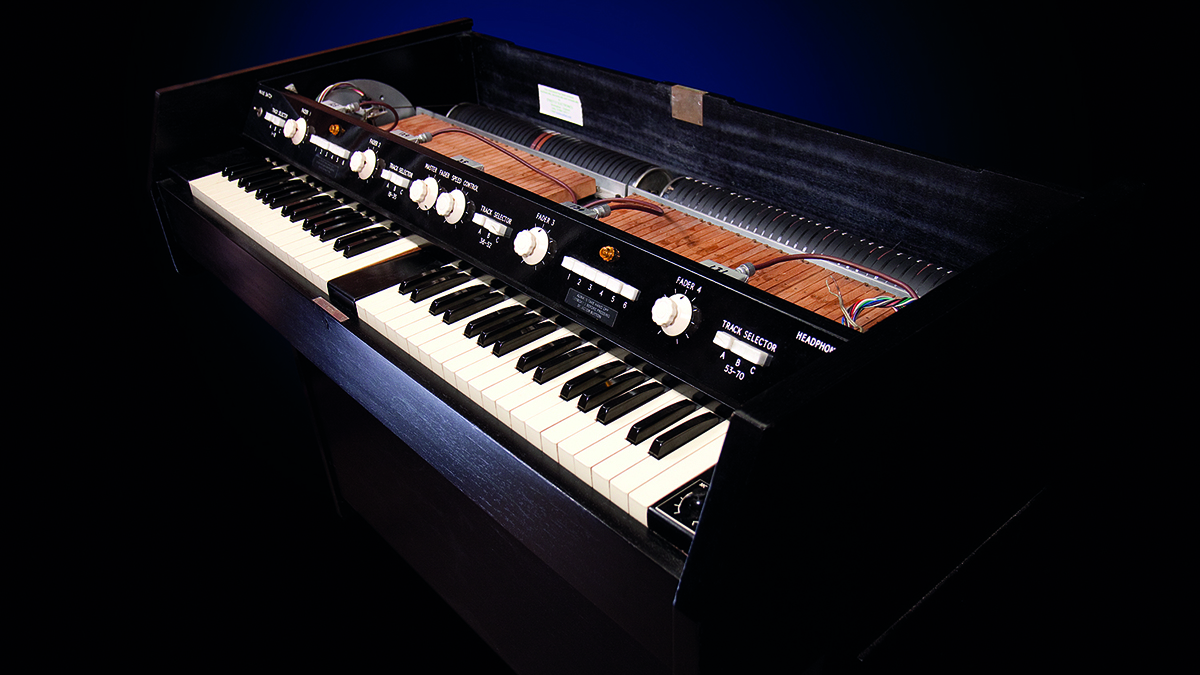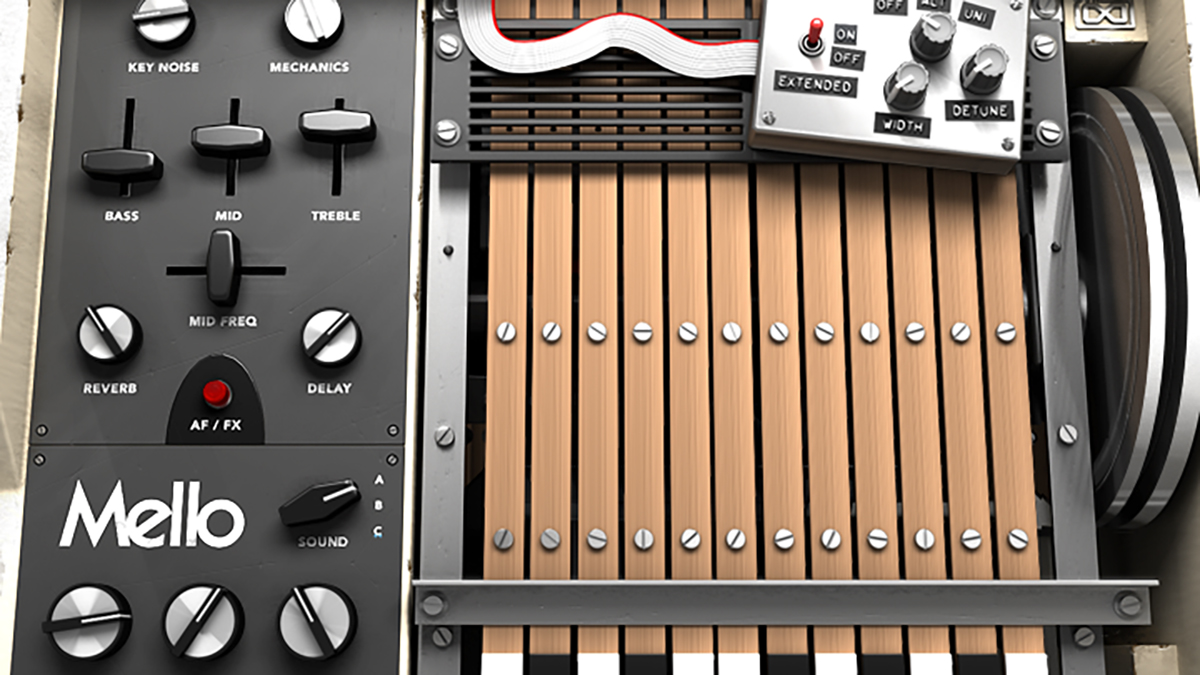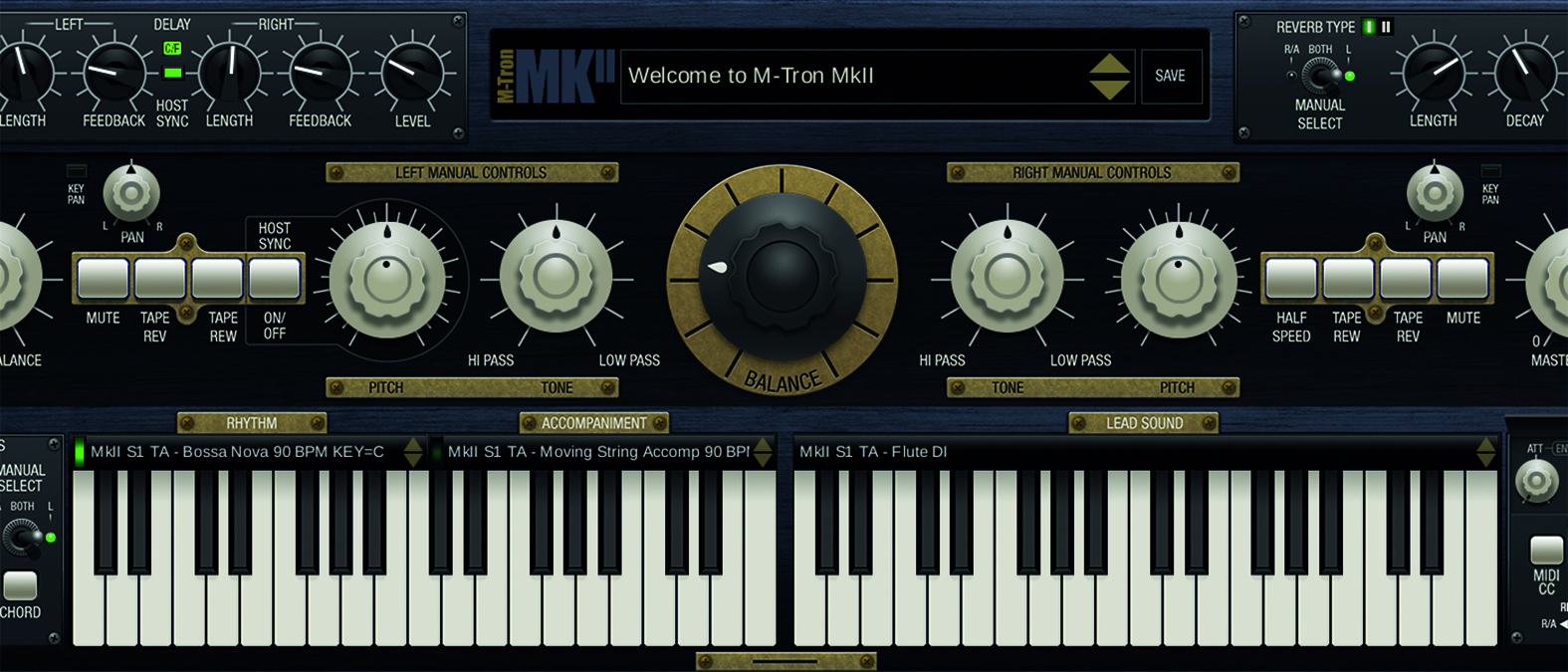MusicRadar Verdict
If you want a Mellotron sound source with vintage character, this is the perfect fit, while providing plenty of inspiration.
Pros
- +
Classic reincarnation of the MkI/II version Mellotrons.
- +
Oozes retro cool and charm.
- +
The samples provide vintage character.
- +
Leads, rhythm accompaniments and artist patches, all included.
Cons
- -
Limited exploration options.
MusicRadar's got your back
GForce Software M-Tron MkII: What is it?
Sixty years ago, when the 60s were really swinging and music technology was in its infancy, an extraordinary instrument appeared. Providing the unthinkable, you could have an instrument in your lounge, which would not be out of place with your home furnishings, that was literally a band-in-a-box!
The much-revered Mellotron is considered to be the first sampler, long before digitisation took effect. Sounds were recorded, and stored on large numbers of tapes, with each providing a set of sounds that could be selected and played at will. The most commonly referred to sound can be heard at the beginning of Strawberry Fields Forever by The Beatles. The haunting flutes, generated by the Mellotron, have become iconic, but the Mellotron was capable of far more than just providing flutes.

The dual-manual Chamberlin and MkI and MkII Mellotrons, provided a two-keyboard setup. The lower keyboard, or ‘manual’ as they’re described, would provide accompaniments and rhythms, while the upper manual would provide lead sounds. We’re all well versed with the Casio concept of the auto-rhythm within the lower section of a home keyboard. Imagine the same scenario, but every time you pressed a note, you heard a full-on traditional rhythm section playing in a variety of different musical styles. Lest we forget, in the case of the Mellotron, every time you pressed down a note, a tape would roll and provide the audio, and unlike your old Casio, that’s a lot of moving parts!
Plugging in!
It’s hardly a surprise therefore, that good quality Mellotrons are rarer than hen’s teeth.
It’s hardly a surprise that good quality Mellotrons are rarer than hen’s teeth. Enter GForce software
Enter GForce software, with their care and passion for vintage equipment, coupled with an extraordinary capacity to reengineer vintage products in plugin form.
M-Tron MkII could be considered a sizeable update to their much adored Mk1 plugin. There is some degree of repetition, from the more familiar sounds, but it now offers a two-manual setup, which can be used across a full 88-note keyboard, or assigned to two smaller keyboards, if you want to go for that classic Mellotron combo look and feel.
GForce Software M-Tron MkII: Performance and verdict
In keeping with the traditions of the original machines, GForce has included all of the Mellotron sounds that were assigned across sections of tape, originally described as ‘Stations’. The hardware models would scroll to the appropriate point on the tape, in order to produce the selected sound. Thankfully, that process isn’t required here, but the concept has remained true. Hence the lower manual provides a full set of rhythms and accompaniments.

• UVI – Mello
The perfect little package, operating from within UVI’s Workstation plugin.
• Logic Pro X – Vintage Mellotron
You may already have access to the included Vintage Mellotron plugin. For a freebie, it’s not bad at all.
Being of a certain era, these styles and accompaniments reflect the musical leanings of the age; you’ll find plenty of swinging rhythms and bossanovas. In fact, the full 132 tapebanks are delivered through the authentic stylings of the new user interface, which includes more than 150 patches. While some of these patches have been heard before through the MkI edition of the plugin, the menus make it abundantly clear where the new content can be found, through the use of the MkII prefix.
Within the lower keyboard manual section, definition can be set between the rhythm section and accompaniments. The rhythm elements are where you will find the rhythmic musings of an acoustic band. The huge advantage of having these in plugin form means that you can synchronise them to the tempo of your DAW, and GForce have done a fantastic job of getting things to play nicely in sync. The accompaniment section, on the other hand, consists of elements such as organ and guitar chords, or even a string section. An indication of the original tempo is provided, so that you can move things to a new tempo that doesn’t sound farcical, but by and large the synchronisation is effective and tight.
Taking the Lead
Switching to the upper manual, this is where you will find the lead sounds. There is plenty of choice in the shape of trumpets, trombones, guitars, violins, and far more. Of course, you also have the classic flute sound, with all sounds open to sample playback via DI or microphone captured samples.
The reworked GUI styling of the front panel is really beautifully done. Located centrally is a balance between the two manuals, while both of the manuals have independent control of a basic see-saw filter, which glides between low and high-pass filtering states. There is also a series of buttons to allow for speed alteration and direction of tape travel. In a somewhat related mode, but albeit performance related, the modulation wheel has been repurposed to provide a form of tape-brake. This is a really nice touch, as it allows the playback of a sample to be interrupted and slowed in real time, through the movement of the mod wheel, and it is highly effective indeed.
Tape-based performance
The M-Tron MkII is a heavyweight plugin; it clearly has one foot in the past, with the resplendent nature of the available samples which provide nostalgia, but with vast scope for contemporary inclusion in production work. There’s a dedicated reverb onboard, in both emulated-spring and modern formats, alongside a delay channel, all of which may be assigned to either the lower rhythm/accompaniment manual, or the upper lead manual. Effects may also be applied to both of the manuals at the same time.
M-Tron MkII is an incredibly appealing plugin, with a beautifully easy level of use
M-Tron MkII is an incredibly appealing plugin, with a beautifully easy level of use. Saving user patches is a simple procedure, and it’s nice to see a layer of artist-based patches too, alongside a patch menu hierarchy. It makes it very plain where the original samples are held, alongside the curated patches. It holds a sonic immediacy when playing, with a stylish identity that clearly resonates with the vintage character of the source material. It’s a highly recommended plugin for vintage aficionados and contemporary producers alike.
MusicRadar verdict: If you want a Mellotron sound source with vintage character, this is the perfect fit, while providing plenty of inspiration.
GForce Software M-Tron MkII: Hands-on demos
GForce Software
Simeon Amburgey
GForce Software M-Tron MkII: Specifications
- Mac: Intel or Apple Silicon Mac (via Rosetta2). macOS 10.15.x or above. 230MB of disk space + 5GB for the library that may be installed on an external hard drive. In the following formats: Standalone Application, AudioUnit, AAX, VST.
- Windows: 2GHz CPU with 2GB RAM. Windows 7 and above. 230MB of disk space + 5GB for the library that may be installed on an external hard drive. In the following formats: Standalone, VST, VST3, AAX.
- CONTACT: GForce Software
Computer Music magazine is the world’s best selling publication dedicated solely to making great music with your Mac or PC computer. Each issue it brings its lucky readers the best in cutting-edge tutorials, need-to-know, expert software reviews and even all the tools you actually need to make great music today, courtesy of our legendary CM Plugin Suite.
"MC5 were playing on the radio": Pere Ubu founder David Thomas has died after “a long illness", aged 71
"An unholy amount of features in a standard-sized compact pedal": Mooer Prime Minimax M2 Intelligent Pedal review
“The most musical, unique and dynamic distortion effects I’ve ever used”: Linkin Park reveal the secret weapon behind their From Zero guitar tone – and it was designed by former Poison guitarist Blues Saraceno’s dad











